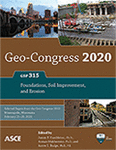Geo-Congress 2020
Ground Improvement for Foundation Support in Organic Soils
Publication: Geo-Congress 2020: Foundations, Soil Improvement, and Erosion (GSP 315)
ABSTRACT
Twenty years ago, most buildings in the United States were supported by either shallow spread footings or deep foundations. Since then, “intermediate” ground improvement options have increased in use, providing building owners, contractors, and engineers with a host of options each with its own unique design and construction characteristics. Loose sands are now often densified, and soft cohesive soils are reinforced with displacement or replacement aggregate piers prior to shallow foundation construction. For heavier loads and softer soils, the subsurface materials are often now reinforced with “rigid inclusions”, typically consisting of cementitious columnar elements installed by either driven-displacement or drilling methods. Organic soils, such as those typically found in New England, the Upper Midwest, and the Pacific Northwest almost always require “improvement” prior to shallow foundation construction because of their inherent compressibility under even small loads. In certain conditions, the organic materials can be reinforced by non-cemented aggregate piers, provided care is used in the appropriate selection of pier stresses to avoid the pier “bulging” and long-term settlement performance issues. In other conditions, such as when the thickness of the organic soils is large, when the loads are heavy, or when the consequences of settlement are severe, more robust solutions, such as those provided by rigid inclusions are necessary. This paper provides the results of multiple case histories in which organic soils have been reinforced by both confined aggregate and cemented ground improvement elements.
Get full access to this article
View all available purchase options and get full access to this chapter.
REFERENCES
Fox, N.S. and Edil, T.B. (2000) “Case Histories of Rammed Aggregate Pier Soil Reinforcement Construction over Peat and Highly Organic Soils,” Proceeding of the Soft Ground Technology Conference, Noordwijkerhout, the Netherlands, May 28-June 2, 2000.
Kraemer, S.R., Condon, R.B. and Wissmann, K.J. (2018). “Rigid Inclusion System Supports Multi-Story Residential and Parking Garage Structures in Organic Soil Profile”. International Foundation Congress and Equipment Expo, Orlando, Florida, March 5-10, 2018.
Mitchell, J.K. (1981) “Soil Improvement: State-of-the-Art,” Tenth International Conference on Soil Mechanics and Foundation Engineering, Stockholm, Sweden, June 1981.
Wissmann, K.J., van Ballegooy, SS, Metcalfe, B.C., Dismuke, J.N., and Anderson, C.K. (2015). “Rammed Aggregate Pier Ground Improvement as a Liquefaction Mitigation Method in Sandy and Silty Soils”. Sixth International Conference on Earthquake Geotechnical Engineering, Christchurch, New Zealand, 1-4 November 2015.
Information & Authors
Information
Published In
Geo-Congress 2020: Foundations, Soil Improvement, and Erosion (GSP 315)
Pages: 684 - 694
Editors: James P. Hambleton, Ph.D., Northwestern University, Roman Makhnenko, Ph.D., University of Illinois at Urbana-Champaign, and Aaron S. Budge, Ph.D., Minnesota State University, Mankato
ISBN (Online): 978-0-7844-8278-0
Copyright
© 2020 American Society of Civil Engineers.
History
Published online: Feb 21, 2020
ASCE Technical Topics:
- Aggregates
- Deep foundations
- Foundation construction
- Foundations
- Geomechanics
- Geotechnical engineering
- Hydraulic engineering
- Hydraulic structures
- Infrastructure
- Pavements
- Piers
- Ports and harbors
- Shallow foundations
- Soft soils
- Soil dynamics
- Soil mechanics
- Soil stabilization
- Soils (by type)
- Spread foundations
- Transportation engineering
- Water and water resources
Authors
Metrics & Citations
Metrics
Citations
Download citation
If you have the appropriate software installed, you can download article citation data to the citation manager of your choice. Simply select your manager software from the list below and click Download.
